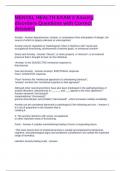MENTAL HEALTH EXAM 2 Anxiety
disorders Questions with Correct
Answers
Anxiety - Answer-Apprehension, tension, or uneasiness from anticipation of danger, the
source of which is largely unknown or unrecognized.
Anxiety may be regarded as *pathological* when it interferes with *social and
occupational functioning, achievement of desired goals, or emotional comfort*
Stress and Anxiety - Answer-*Stress*, or more properly, a *stressor*, is an external
pressure that is brought to bear on the individual.
*Anxiety* is the SUBJECTIVE emotional response to
that stressor.
Fear and anxiety - Answer-Anxiety= EMOTIONAL response
Fear= COGNITIVE response
*Fear* involves the *intellectual appraisal of a threatening stimulus*;
*anxiety* involves the *emotional response to that appraisal.*
Although other neurotransmitters have also been implicated in the pathophysiology of
anxiety disorders, disturbances in __, ___, and ___ appear to be most significant. -
Answer-serotonin *(increased)*
norepinephrine *(increased)*
gamma-aminobutyric acid (GABA) *(decreased)* , which increases cellular excitability.
Anxiety can be considered abnormal or pathological if the following are true: - Answer-1.
It is out of proportion to the situation that is
creating it.
2. The anxiety interferes with social, occupational,
or other important areas of functioning.
Panic - Answer-A sudden overwhelming feeling of terror or impending doom.
-This most severe form of emotional anxiety is usually accompanied by behavioral,
cognitive, and physiological signs and symptoms considered to be outside the expected
range of normalcy.
Hamilton Anxiety Rating scale - Answer-
,Levels of anxiety: Adaption responses on a continuum of anxiety - Answer-
levels of anxiety - Answer-
Mild anxiety: - Answer--occurs in normal experiences of everyday living
-increases one's ability to perceive reality
-identifiable cause of anxiety
-*vague* feeling of mild discomfort, restlessness, irritability, and apprehension
-may experience *behaviors* such as finger-foot tapping, fidgeting, or lip-chewing as
*mild-tension relieving behaviors*
Moderate anxiety - Answer--although ability to think clearly is hindered, problem solving
and learning may still occur
The client with this type of anxiety usually benefits from direction of others
Severe anxiety - Answer--Perceptual field is so greatly reduced with distorted
perceptions that the client can only concentrate on that one problem
-Learning and problem solving *DO NOT OCCUR* ; *functioning is ineffective*
-*Physical symptoms*
(e.g., headaches, palpitations, insomnia)
-*emotional symptoms* (e.g., confusion, dread, horror) may be evident
-client with severe anxiety *usually is not able to take direction from others*
-*Discomfort is experienced to the degree that virtually all overt behavior is aimed at
relieving the anxiety*
Panic attack: *7* - Answer-- the individual is *unable to focus on even one detail within
the environment.*
-Misperceptions are common, *and a loss of contact with reality may occur.*
-may experience hallucinations or delusions.
-Behavior may be characterized by wild and desperate actions or extreme withdrawal.
-*Human functioning and communication with others are ineffective.*
*"feeling as if they're going to die"
-can be life threatening; lead to physical and emotional exhaustion
Generalized anxiety disorder - Answer-is characterized by *persistent, unrealistic, and
excessive anxiety and worry,* which have occurred more days than not for at least 6
months and cannot be attributed
to specific organic factors.
Anxiety and worry often result in procrastination in behavior or decision-making, and the
individual repeatedly seeks reassurance from others.
, Panic attack characterstics - Answer-1. "Flight and fight" symptoms
-*Racing heart, chest pains, dizziness and nausea, chocking sensations, breathing
difficulties, numbness and tingling, trembling and diaphoresis*
2. Feelings of having a heart attack
3. Feelings of going crazy
4. Fear of loss of control
5. Decreased perceptual ability
6. Decreased cognitive abilities
Anxiety disorders: Substance Induced - Answer-Symptoms of anxiety due to the use of
a substance or within a month of stopping using it.
Anxiety disorders: General Medical Condition - Answer-Symptoms of anxiety are a
direct physiological result of a medical condition.
The Diagnostic and Statistical Manual of Mental Disorders, Fifth Edition (DSM-5)
(American Psychiatric Association [APA], 2013) states that *at least four* of the
following symptoms must be present to identify the presence of a panic attack. -
Answer-■ Palpitations, pounding heart, or accelerated
heart rate
■ Sweating
■ Trembling or shaking
■ Sensations of shortness of breath or smothering
■ Feelings of choking
■ Chest pain or discomfort
■ Nausea or abdominal distress
■ Feeling dizzy, unsteady, lightheaded, or faint
■ Chills or heat sensations
■ Paresthesias (numbness or tingling sensations)
■ Derealization (feelings of unreality) or depersonalization
(feelings of being detached from
oneself)
■ Fear of losing control or going crazy
■ Fear of dying
Panic disorder (P.D.): Assessment - Answer--Characterized by recurrent panic attacks,
onset of which are unpredictable.
-Manifested by *intense apprehension, fear, or terror* associated with feelings of
impending doom and intense physical discomfort.
Panic Disorder (P.D.) with *Agoraphobia:* Assessment - Answer--Characterized by
same symptoms characteristic of panic disorder.
-In addition, affected person experiences a *fear of being in places or situations from
which escape might be difficult or in which help might not be available in the event of a
panic attack*




